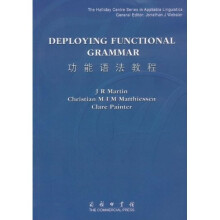功能语法教程

目 录内容简介
Prefacei
Chapter 1 Introduction1
1. What is functional grammar?1
2. Why this functional grammar?2
3. Using the workbook 3
4. Getting started with text analysis5
5. Constituency: functional and class units7
6. Reasoning in a functional grammar10
7. Paradigms as system networks13
8. Choice and constituency16
9. Learning to use IFG19
Chapter 2 Theme —— clause as message 21
1. Orientation 21
1.1 Reading guide to IFG21
1.2 Characterisation of Theme21
1.3 Thematic devebpment within a text22
2. Survey of options22
2.1 Ideational (topical} Theme24
2.2 Interpersonal Theme25
2.3 Textual Theme25
2.4 Summary of types of Theme26
2.5 Extending the thematic principle beyond the clause27
3. Troubleshooting 28
3.1 Picking out the unit of analysis28
3.2 Identifying the Theme28
3.3 Identifying the metafunction29
3.4 Subject it as unmarked topical Theme32
3.5 There's a...: 'Existential' clauses35
3.6 Recognising longer Theme units35
3.7 'Hypotactic' clause as Theme37
4. Analysis practice38
4.1 Phase I38
4.2 Phase II40
4.3 Phase III47
5. Review and contextualisation52
5.1 Defining Theme52
5.2 The location of THEME within the grammatical resources of English 52
5.3 Theme and Metafunction53
5.4 Theme and Mood54
Further reading54
Chapter 3 Mood —— clause as exchange56
1. Orientation 56
1.1 Reading guide to IFG56
1.2 Characterisation of Mood56
2. Survey of options59
2.1 Basic MOOD types60
2.2 Overall interpersonal organisation of the clause60
2.3 Interpersonal grammatical metaphor67
3. Troubleshooting69
3.1 The unit ofanalysis69
3.2 Identifying structural elements70
3.3 Ambiguous mood type75
3.4 Ambiguous polarity76
4. Analysis practice77
4.1 PhaseI77
4.2 Phase II82
4.3 Phase III89
5. Review and contextualisation93
5.1 Locating MOOD93
5.2 Interpersonal structure95
5.3 Interpersonal structure and textual structure95
Further reading96
Chapter 4 Transitivity—— clause as representation98
1. Orientation98
1.1 Reading guide to IFG98
1.2 Characterisation of TRANSITIVITY98
2. Survey of optionsI00
2.1 Material clauses102
2.2 Mental clauses103
2.3 Relational clauses104
2.4 Verbal clauses106
2.5 Behavioural clauses: between material and mental/verbal107
2.6 Existential clauses108
2.7 Additional Agents108
2.8 Ergative interpretation109
3. Troubleshooting112
3.1 A topology of processes112
3.2 General probes helpful in analysing for TRANSITIVITY 113
3.3 One process or two?ii4
3.4 Material clauses115
3.5 Mental clauses118
3.6 Relational clauses120
3.7 Verbal clauses124
3.8 Behavioural clausesI25
3.9 Discriminating circumstance type126
3.10 Distinguishing between circumstances and other elements126
4. Analysis practice130
4.1 Phase I130
4.2 Phase II137
4.3 Phase IIl146
5. Review and contextualisation153
5.1 The clause as experiential construct153
5.2 Ergative perspective155
5.3 Relation to other metafunctions155
Further reading159
Chapter 5 Group and phrase —— below the clause161
1. Orientation161
1.1 Reading guide to IFG161
1.2 Characterisation of groups/phrases161
2. Survey of options165
2.1 Nominal group165
2.2 Verbal group171
2.3 Other groups182
2.4 Prepositional phrase183
3. Troubleshooting185
3.1 Identifying groups/phrases185
3.2 Assigning a function to a word in a group186
3.3 Different meanings for prepositions196
3.4 Assigning a function to a phrase or a clause: ranking or embedded?198
4. Analysis practice200
4.1 Nominal group201
4.2 Verbal group212
4.3 Adverbial group & Prepositional phrase224
5. Review and contextualisation224
5.1 Locating groups & phrases: rank and metafunction224
5.2 Nominal group225
5.3 Verbal group226
5.4 Prepositional phrase 226
Further reading 227
Chapter 6 The clause complex —— above the clause229
1. Orientation229
1.1 Reading guide to IFG229
1.2 Characterisation of clause complex229
2. Survey of options231
2.1 TAXlS 231
2.2 Logico-semantic type234
2.3 Summary of clause complex relations237
3. 'Troubleshooting 238
3.1 Procedure for analysis238
3.2 Picking out the unit of analysis238
3.3 Complexing vs. embedding242
3.4 Parataxis or hypotaxis?247
3.5 Identifying the logico-semantic relation248
3.6 How many 'layers' to the clause complex?250
3.7 Implicit clause complex relations251
3.8 Projection251
3.9 'Surfacing' from an embedding252
4. Analysis practice253
4.1 Phase I253
4.2 Phase II259
4.3 Phase lII265
5. Review and contextualisation268
5.1 Review268
5.2 Relations between clauses270
Further reading 271
Chapter 7 Text analysis 272
1. Orientation272
1.1 Reading guide to IFG272
1.2 Characterisation of text analysis 272
2. Grammar and beyond274
2.1 Theme and information flow276
2.2 Clause complexing and conjunction278
2.3 Transitivity and ideation283
2.4 Nominal groups, ideation and identification284
2.5 Periodicity and appraisal288
2.6 Deixis and multimodality 291
3. Text analysis cartography293
References 299
Index303
Chapter 1 Introduction1
1. What is functional grammar?1
2. Why this functional grammar?2
3. Using the workbook 3
4. Getting started with text analysis5
5. Constituency: functional and class units7
6. Reasoning in a functional grammar10
7. Paradigms as system networks13
8. Choice and constituency16
9. Learning to use IFG19
Chapter 2 Theme —— clause as message 21
1. Orientation 21
1.1 Reading guide to IFG21
1.2 Characterisation of Theme21
1.3 Thematic devebpment within a text22
2. Survey of options22
2.1 Ideational (topical} Theme24
2.2 Interpersonal Theme25
2.3 Textual Theme25
2.4 Summary of types of Theme26
2.5 Extending the thematic principle beyond the clause27
3. Troubleshooting 28
3.1 Picking out the unit of analysis28
3.2 Identifying the Theme28
3.3 Identifying the metafunction29
3.4 Subject it as unmarked topical Theme32
3.5 There's a...: 'Existential' clauses35
3.6 Recognising longer Theme units35
3.7 'Hypotactic' clause as Theme37
4. Analysis practice38
4.1 Phase I38
4.2 Phase II40
4.3 Phase III47
5. Review and contextualisation52
5.1 Defining Theme52
5.2 The location of THEME within the grammatical resources of English 52
5.3 Theme and Metafunction53
5.4 Theme and Mood54
Further reading54
Chapter 3 Mood —— clause as exchange56
1. Orientation 56
1.1 Reading guide to IFG56
1.2 Characterisation of Mood56
2. Survey of options59
2.1 Basic MOOD types60
2.2 Overall interpersonal organisation of the clause60
2.3 Interpersonal grammatical metaphor67
3. Troubleshooting69
3.1 The unit ofanalysis69
3.2 Identifying structural elements70
3.3 Ambiguous mood type75
3.4 Ambiguous polarity76
4. Analysis practice77
4.1 PhaseI77
4.2 Phase II82
4.3 Phase III89
5. Review and contextualisation93
5.1 Locating MOOD93
5.2 Interpersonal structure95
5.3 Interpersonal structure and textual structure95
Further reading96
Chapter 4 Transitivity—— clause as representation98
1. Orientation98
1.1 Reading guide to IFG98
1.2 Characterisation of TRANSITIVITY98
2. Survey of optionsI00
2.1 Material clauses102
2.2 Mental clauses103
2.3 Relational clauses104
2.4 Verbal clauses106
2.5 Behavioural clauses: between material and mental/verbal107
2.6 Existential clauses108
2.7 Additional Agents108
2.8 Ergative interpretation109
3. Troubleshooting112
3.1 A topology of processes112
3.2 General probes helpful in analysing for TRANSITIVITY 113
3.3 One process or two?ii4
3.4 Material clauses115
3.5 Mental clauses118
3.6 Relational clauses120
3.7 Verbal clauses124
3.8 Behavioural clausesI25
3.9 Discriminating circumstance type126
3.10 Distinguishing between circumstances and other elements126
4. Analysis practice130
4.1 Phase I130
4.2 Phase II137
4.3 Phase IIl146
5. Review and contextualisation153
5.1 The clause as experiential construct153
5.2 Ergative perspective155
5.3 Relation to other metafunctions155
Further reading159
Chapter 5 Group and phrase —— below the clause161
1. Orientation161
1.1 Reading guide to IFG161
1.2 Characterisation of groups/phrases161
2. Survey of options165
2.1 Nominal group165
2.2 Verbal group171
2.3 Other groups182
2.4 Prepositional phrase183
3. Troubleshooting185
3.1 Identifying groups/phrases185
3.2 Assigning a function to a word in a group186
3.3 Different meanings for prepositions196
3.4 Assigning a function to a phrase or a clause: ranking or embedded?198
4. Analysis practice200
4.1 Nominal group201
4.2 Verbal group212
4.3 Adverbial group & Prepositional phrase224
5. Review and contextualisation224
5.1 Locating groups & phrases: rank and metafunction224
5.2 Nominal group225
5.3 Verbal group226
5.4 Prepositional phrase 226
Further reading 227
Chapter 6 The clause complex —— above the clause229
1. Orientation229
1.1 Reading guide to IFG229
1.2 Characterisation of clause complex229
2. Survey of options231
2.1 TAXlS 231
2.2 Logico-semantic type234
2.3 Summary of clause complex relations237
3. 'Troubleshooting 238
3.1 Procedure for analysis238
3.2 Picking out the unit of analysis238
3.3 Complexing vs. embedding242
3.4 Parataxis or hypotaxis?247
3.5 Identifying the logico-semantic relation248
3.6 How many 'layers' to the clause complex?250
3.7 Implicit clause complex relations251
3.8 Projection251
3.9 'Surfacing' from an embedding252
4. Analysis practice253
4.1 Phase I253
4.2 Phase II259
4.3 Phase lII265
5. Review and contextualisation268
5.1 Review268
5.2 Relations between clauses270
Further reading 271
Chapter 7 Text analysis 272
1. Orientation272
1.1 Reading guide to IFG272
1.2 Characterisation of text analysis 272
2. Grammar and beyond274
2.1 Theme and information flow276
2.2 Clause complexing and conjunction278
2.3 Transitivity and ideation283
2.4 Nominal groups, ideation and identification284
2.5 Periodicity and appraisal288
2.6 Deixis and multimodality 291
3. Text analysis cartography293
References 299
Index303
目 录内容简介
《功能语法教程》旨在讲授及实践国际知名语言学家韩礼德所设计的多种语法分析方法,是一部适用于教学和应用方面的工具书。《功能语法教程》与韩礼德所著的《功能语法入门》(Introduction to Functiona1 Grammar)第二版和第三版相互参照。《功能语法教程》总结介绍了韩礼德关于小句复合体、分句、语义组和短句语法的主要观点,阐明了普遍被视为艰深的课题,并附有一系列分级练习,供学生演练学习语法分析技巧用。此外,《功能语法教程》另有一章将上述语法分析同韩礼德富有创意的话语分析、语域及文体方面的研究工作相结合。
任何对功能语言学篇章分析有兴趣的人士以及希望把韩礼德对语法的真知灼见加以实践的人士,都会发现《功能语法教程》是一本理想读物。《功能语法教程》可单独用作教科书讲授功能语法的课程,亦可配合韩礼德所著的《功能语法入门》(Introduction to Functional Grammar)或其他相关入门书籍使用。阅读《功能语法教程》无需先熟悉功能语法方面的知识,其读者对象不仅是初学者,也包括对语言学专门知识及对韩礼德的著作熟悉程度各异的其他读者。
任何对功能语言学篇章分析有兴趣的人士以及希望把韩礼德对语法的真知灼见加以实践的人士,都会发现《功能语法教程》是一本理想读物。《功能语法教程》可单独用作教科书讲授功能语法的课程,亦可配合韩礼德所著的《功能语法入门》(Introduction to Functional Grammar)或其他相关入门书籍使用。阅读《功能语法教程》无需先熟悉功能语法方面的知识,其读者对象不仅是初学者,也包括对语言学专门知识及对韩礼德的著作熟悉程度各异的其他读者。
比价列表
1人想要
公众号、微信群
 缺书网
缺书网微信公众号
 扫码进群
扫码进群实时获取购书优惠





